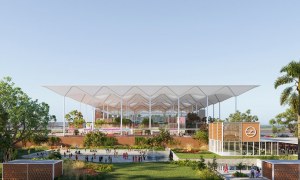🕑 Reading time: 1 minute
ByBlock, developed by ByFusion, is the very first construction-grade building material made entirely from plastic waste. This advanced building material is particularly more intriguing as it is made completely from recycled (and often unrecycled) plastic waste.
The construction industry has witnessed the invention and incorporation of numerous green and sustainable materials during recent times. This has seen a growing acceptance for the use of naturally-occurring materials like bamboo and straw bale as well as many man-made net-zero concrete options.
ByBlocks are easy-to-use, eco-friendly, and inexpensive, suitable for residential or commercial settings. Not only do they generate 41% lesser greenhouse gas emissions than concrete blocks, they produce no waste and can be created using construction residuals. These can be used for retaining walls, sound walls, sheds, terracing, and landscaping, furniture, etc.
Properties of ByBlocks
With a width of 16”, height of 8”, and depth of 8”, ByBlocks are similar in dimension to a standard concrete cinder block (CMU). Each ByBlock weighs 10 kg and can be used to provide a sturdy, reliable, and well-insulated structure.
A ByBlock includes two clearance holes to run metal rods through it. There are two pins situated on the top and two dimples on the bottom to connect to one another while stacking the ByBlocks.
ByBlocks are customizable to specific densities and can be installed 75% faster than a concrete block or brick. Construction with ByBlocks can help save 50% in material and labor expenses, and it produces 41% fewer greenhouse gas emissions than concrete blocks. They don’t crack or crumble, unlike concrete blocks.
The plastic composition of these blocks makes them insect- and water-proof. As plastic does not absorb moisture, these blocks will actually float when submerged.
Production of ByBlocks
Defined as a sustainable, high-performing construction material, the first step towards the production of ByBlocks is the collection of discarded plastic waste, which undergoes shredding. The plastic is then superheated and fused into ByBlocks.
So, the first question is, why use plastic? The innate properties of plastic, such as its malleability, insulation, and its tendency to not degrade easily, make it one of the most powerful building materials.
ByFusion uses their proprietary system of utilizing only steam and compression maximizes these traits by processing any kind of recovered plastic waste into ready-made building materials.
Building with ByBlocks
For construction with ByBlocks, the required primary materials include threaded rod, washers and nuts, lumber or steel top plates, base mounting hardware, and covering. No additives or fillers, glues, or mortars are needed for binding the blocks; the rods are secured within the base and extend through each ByBlock with the pins and dimples locking together.
The base material could be concrete/cement, lumber, or steel. Concrete provides a few options for anchoring the metal rods, by placing the rods in cement when it is poured, drilling holes in concrete, and either by installing drop-in anchors or use epoxy.
After stacking the ByBlocks, a top plate is placed on the final course and secured using washers and nuts. The nuts can be tightened to draw the ByBlock courses together and lock them tightly into position. This feature imparts strength into a ByBlock wall assembly. Following the tightening of nuts and compression of the walls, the extra rod can be cut back. The final step includes the addition of a finish such as stucco, sheetrock/drywall, plaster, specialized paints, etc.
Read More
Wood as Construction Material – Types, Structure, Processing
Types of Failures Experienced by Different Construction Materials Used in Structures
Carbon Fiber Fabric as Building Material – Properties and Uses



